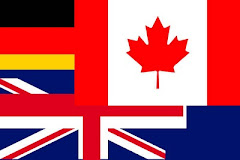Well since I was trained as a cataloguer and it was one of my responsibilities during many years of my library career, I thought I'd better take part in this one.
When I took my training at Sheridan College, we learned both the Dewey Decimal Classification System and the Library of Congress system. Because the Dewey Decimal System is the one used by most public libraries, we spent more time on it. The College Library used Library of Congress.
I explain to people that the Classification Number is the Address of the Book. Knowing it will help you quickly find a specific book found listed in the catalog.
The Dewey Decimal System divides knowledge into 1000 different numbers. Each main field is a grouping of one hundred. As the number gets larger you define the subject matter more closely.
So where would a genealogist find books of interest?
000's - Generalities - bibliographies and information on libraries and archives.
100's - Paranormal, Philosophy and Psychology - ghost stories of an area
200's - Religion - information about religions, Church histories and biographies of ministers
300's - Sociology - voters' lists, elections, politicians, profiles of communities, information on different ethnic groups, transportation history, military history, education, school histories and registers, folktales and legends
400's - Language - Dictionaries
500's - Sciences - native plants
600's - Applied Science - technology, inventions, medicines and home remedies, diseases, genetics, DNA, agriculture
700's - Arts and Crafts of a culture
800's - Literature - famous local writers
900's - Geography and History - geography of the area, maps, history of local, national and world events.
971.318 - is for history of Grey County
In the 900's you will find the 929 section. This is the main number for genealogical materials.
With that number you can subdivide it more with a decimal.
929.1 How to
929.2 Family Histories
929.3 Sources - Census indexes, Newspaper index and extractions
929.4 Personal Names
929.5 Cemeteries - transcriptions
Local histories will be in the 940s to 999s depending on where you are.
After the number you will will find some letters which usually represent the first 3 or 5 letters of the author's surname and on occasion the first 3 or 5 letters of the title.
So as you can see, when doing genealogical and family research, you do not just look in the 900's.
For the Library of Congress Classification System, I had to check the about.com database as it is so long since I worked with it and I never used it any of my work. When I worked in the college library as a student, we didn't catalog in house. The LC classification is made up of letters to divide knowledge into areas. The first letter represents one of 21 areas.The second letter divides into a sub-category. The numbers that follow further subdivide the topic.
CS - is the section where the books specific to genealogy would be located.
Assigning the classification number, which determines where the book or other item is found in the library, is only one aspect of the cataloging process. There is also the descriptive details and the subject, title and added entries for illustrators and additional authors.
© 2010 Janet Iles
Subscribe to:
Post Comments (Atom)





No comments:
Post a Comment
Comments are moderated before being posted. Please no links in your comments. The blog author reserves the right to not post a comment if deemed inappropriate.